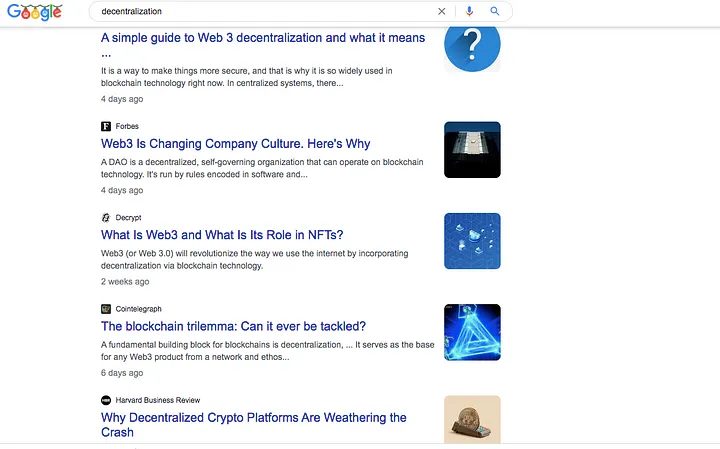Blockchain (with or without cryptocurrencies) is touted as THE solution for decentralizing financial and technological services. The hype around Blockchain (and the related term Web3) is so much that all other solutions for decentralization get drowned in it. For example below is a snapshot of search results when I did a search on Google news for the word “decentralization”. Most of the results are around Web3 and Blockchain.

In itself, Blockchain is a great technology with immense potential to disrupt financial services. But that is not the be all and end all of decentralization. It has become a fad mainly because of the price appreciation of several cryptocurrencies/tokens usually associated with Blockchain. It is important to not mix up the two words — decentralization and Blockchain. Web3 is another word that is being used synonymously with Blockchain, although there could be several technologies that can claim to be Web3.
Before we dig deeper, let us understand why decentralization is important in the first place. Firstly, decentralization improves efficiency by moving control closer to the end user. Secondly, it makes systems more robust by removing single point(s) of failure. Thirdly, rent-seeking monopolies will be hard to find in a decentralized environment thus leading to more equitable distribution of wealth and power. Finally, decentralization helps in censorship resistance (by governments or corporations). All of these are lofty goals, if finance and technology were to be truly democratized.
Once upon a time, even the financial world was mostly decentralized. Physical commodities (à la gold) were used as money and all transactions are by definition peer to peer without a central intermediary. Lending and borrowing was also mostly done between peers (i.e person to person). But as technology improved and people sought more efficiencies in financial transactions, banks started emerging as centralized solution providers to the financial needs of people. Thence, Blockchain was invented for a specific purpose — to reverse this centralization and to make money (and hence finance) P2P/decentralized again. Hence its architecture revolves around keeping a ledger of accounts that all parties agree or are forced to agree as universal truth. This construct is useful where systems are transaction intensive and rely upon strict rules of settlement. Most financial systems (including payments) require this. But such strictness is not required in other walks of life. For example, if one wants to distribute some content (let’s say a status message) to the world freely, one need not worry about the transfer trail of the content. In such cases, Blockchain will be an overkill. Nevertheless such solutions are being attempted in the so-called Web3 world: https://builtin.com/blockchain/media-social-media-entertainment-uses. Not just in social media, Blockchain is being used to solve several problems without a need for it — including problems in healthcare, gaming, video content, travel etc.
Even in the domain of finance, not every solution needs to incorporate Blockchain as there are several areas in finance that rely on data that may not have single universal truth (credit score of companies/individual for example). In most of these cases, one can design more efficient solutions for decentralization rather than using Blockchain. Of course development of Blockchain is a great revolution as it has solved the tough problem of maintaining decentralized ledgers of accounts. But other technologies also emerged recently that can take decentralization to the next level. Some of these include: decentralized file sharing (bittorrent, ipfs etc), peercasting/p2p video sharing, network sharing, distributed computing (for example Holochain) etc. All of these could ideally have been clubbed under the term Web3. But because this term got hijacked by the Blockchain ecosystem, may be we can use alternative terms like “Decentralized Computing” or “P2P Computing” or “Fog Computing” for the revolution that is to come